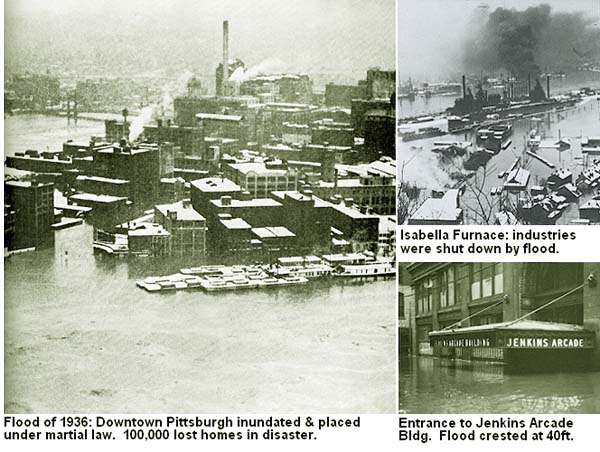 Historic photos from Pittsburgh: The Story of an American City by Stefan Lorant
Historic photos from Pittsburgh: The Story of an American City by Stefan Lorant
Thomas Walker and his partner took advantage of Pittsburgh’s prime location to establish a steel fabrication business in 1863. Pittsburgh was an excellent location for heavy industry because it sits where the Allegheny and Monongahela Rivers merge to form the mighty Ohio. In 1863 the rivers were a source of water for both drinking and industrial processes. The rivers were also transportation arteries, providing easy access to raw materials barged in from surrounding mines and mills. The flat land bordering the rivers provided ideal corridors for laying the first railroad lines shipping finished goods across the nation.
The rivers became contaminated due to being a disposal location for sewage and industrial waste. The city experienced a series of cholera and typhoid epidemics of increasing severity. Pittsburgh had the highest typhoid fever mortality rate of any city in the nation between 1872 and 1908.
1 Clara Walker, the mother of tne Foundation's first trustees, became seriously ill after contracting typhoid fever as a young girl around 1898. It was many years before she fully recovered.
2
Thomas Walker served on the Water Board of Pittsburgh at the time the water filtration plant was constructed. Construction began in 1904. Chlorine disinfection was initiated in 1911. By 1923 the City had the distinction of having the largest sand filtration plant in the world.
3 Despite recognizing the need to clean up it’s own water supply, the City and industrial plants continued to dispose of waste where it affected other communities downstream. Eventually water pollution became a national issue, leading to passage of the Federal Water Pollution Control Act in 1948. Amended and strengthened in 1972, the law became commonly know as the Clean Water Act.
4
After earning a degree in mechanical engineering, Tom, Sr. recalls working at Columbia Steel and Shafting. Acid used to “pickle”, or clean finished steel, was dumped in the creek that flowed beside the mill. However in 1950, soon after he began working there, pollution regulations prohibited dumping of acid. The Mill responded by developing a way to clean hard, finished steel by blasting it with soft steel shot.
As the area around Pittsburgh became settled and the surrounding forests were cut, flooding along the rivers began to increase. Both family steel businesses experienced costly episodes of flooding. The McVay & Walker Co. plant was located along the Monongahela River. Columbia Steel and Shafting Co. was in a bend of Charters Creek. Flooding became an increasing problem for Pittsburgh’s industry.
In 1908 the Chamber of Commerce adopted a resolution establishing a flood committee. The committee raised money and four years later issued it’s report calling for reforestation, conservation of existing forests, and construction of storage reservoirs in the headwaters.
We don’t know Thomas Walker’s view on flood control, but we do know that industrialists and leading citizens were members of the Flood Commission supporting a scientific approach to reforest denuded watersheds upstream from Pittsburgh. The watersheds spanned the states of Pennsylvannia, New York and West Virginia. Efforts by the Flood Commission opened the way for the Federal Government to purchase logged private lands for reforestation under the Weeks act of 1911. By the time of the 1936 flood over half the two million acres authorized for purchase had been acquired, but it took another generation for the forests to regenerate.
Construction of upstream reservoirs took longer because, at the time, the Federal government only acted in the interest of maintaining navigable waterways. Furthermore, an economic study concluded the befefits of expensive flood control measures were not woth the cost. By looking at the past frequency of floods, the study ignored the impact human developement was having on the environment. Development was increasing the frequency of floods, but the study did not take the increased flood frequency into account. The disastrous 1927 Mississippi Valley Flood forced 700,000 people out of their homes and began to change public opinion on expanding the role of the Federal government. During the early 1930’s drought conditions and lack of runoff from deforested lands resulted in complete suspension of navigation on the upper Monongahela River. Finally, the Pittsburgh Flood of 1936 led business and political leaders to work with 400 communities in the tri-state area to launch a coordinated campaign, resulting in Congress passing the Flood Control Act of 1936. The Act authorized the construction of nine flood control reservoirs above Pittsburgh.
5
- Pittsburgh’s Dark History, Popular Pittsburgh, Feb 11, 2015, http://popularpittsburgh.com/darkhistory/
- George Clark, relating a conversation many years earlier with his “Aunt Clara”
- History of the Pittsburgh Public Water Supply, City of Pittsburgh Powerpoint Presentation,
apps.pittsburghpa.gov/pwsa/History_of_the_Pittsburgh_Public_Water_Supply2.ppt
- Summary of the Clean Water Act, U.S. EPA website, 2015
- Pennsylvania History vol. 42, no. 1, January 1975: The Politics of Pittsburgh Flood Control, 1908-1936, by Roland M. Smith
Previous Next